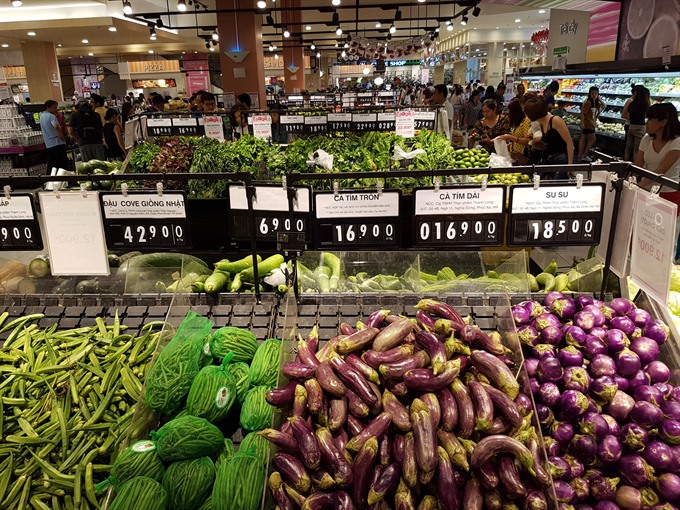 Economy
Economy

The consumer price index (CPI) in October rose 0.41 per cent from the previous month and 2.98 per cent year-on-year, according to the General Statistics Office (GSO).
 |
| Vegetables and fruits arranged for sale at the shopping centre AEON MALL Long Biên in Hà Nội. The consumer price index (CPI) in October increased by 0.41 per cent over September. The uptick means the average CPI for the 10-month period has risen 3.71 per cent year on year. — VNS Photo Thái Hà |
HÀ NỘI — The consumer price index (CPI) in October rose 0.41 per cent from the previous month and 2.98 per cent year-on-year, according to the General Statistics Office (GSO).
That meant the average CPI for the last 10 months rose 3.71 year-on-year – the highest growth rate in the last three years. It was up 2.25 per cent from December 2016.
According to the GSO, the inflation rate of 3.71 per cent is still below the expected level for 2017, which is estimated at 4 per cent.
However, the inflation rate could rise in the last two months of the year on the rapid increase in demand for goods and services and on increasing credit issuance and investment to push up the country’s economic growth, GSO warned.
In October, all 11 major commodity groups posted growth compared to nine of those groups making gains in September.
Medicines and healthcare services recorded the highest growth rate of 2.14 per cent as seven provinces and cities under direct management of the central government, including Hà Nôi, HCM City and Đà Nẵng, raised healthcare service charges towards patients without health insurance. Charges were increased by private clinical centres in the central highland provinces of Kon Tum and Gia Lai.
The price indices for food and foodstock were up 0.37 per cent and 0.57 per cent, respectively, due to heavy damages from storms and floods to the farming conditions of northern mountainous and central provinces, and high demand for food products during the wedding season.
Among other groups that saw price indices rise were housing and construction material (0.63 per cent), transportation (0.61 per cent) and food stores and restaurants (0.31 per cent).
Some groups that posted declines in CPI included electricity, sand, gold and pork.
The price of pork was down 0.95 per cent in October as consumers worried about the quality of meat products after local media reported nearly 4,000 pigs were injected with tranquiliser and sold on the market.
Storms and rain during October also reduced power consumption, cutting electricity prices by 0.24 per cent. Meanwhile, sand prices fell by 5 to 15 per cent across the country as some southern provinces allowed sand mines to be re-opened and demand of construction sand declined due to the rainy season.
Domestic gold price declined along with the global gold price. By October 25, the average global gold price fell 2.83 per cent from the previous month to US$1,284.4 an ounce, pulling the average domestic gold price down by 0.88 per cent to VNĐ3.65 million ($162.2) per tael in October.
The exchange rate between the Vietnamese đồng and the US dollar remained stable in October as the supply of foreign currencies was sufficient to meet local enterprises’ demand. The average exchange rate between the đồng and dollar in October stayed around VNĐ22,710 per dollar.
According to the GSO, core inflation in October rose 0.06 per cent from the previous month and 1.32 per cent over one year.
Ten-month inflation increased by 1.44 per cent year on year, lower than the projected figure of 1.6 to 1.8 per cent, proving that the monetary policy has been carried out effectively. — VNS




